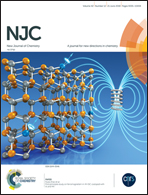Preparation of a temperature-responsive block copolymer-anchored graphene oxide@ZnS NPs luminescent nanocomposite for selective detection of 2,4,6-trinitrotoluene†
Abstract
Novel temperature-responsive block copolymer-functionalized graphene oxide (GO) nanosheets were successfully prepared via non-covalent π–π stacking interactions between GO and pyrene-terminated PNIPAM-b-P(OEGMA-co-MQ). The pyrene-terminated block copolymer was synthesized by reversible addition fragmentation chain transfer (RAFT) polymerization using a pyrene functional RAFT agent and the monomers N-isopropylacrylamide (NIPAM), oligo(ethylene glycol) monomethyl ether methacrylate (OEGMA) and 5-(2-methacryloyl-ethyloxymethyl)-8-quinolinol (MQ). ZnS nanoparticles were also integrated into the block copolymer-decorated GO via the coordination of MQ units of the block copolymers to fabricate a fluorescent nanocomposite with good temperature-responsive behavior based on a conformation change in the PNIPAM blocks on the GO sheets. The as-prepared block copolymer anchored graphene oxide@ZnS NPs nanocomposite can be used as a fluorescent sensing platform for sensitive and selective detection of nitroaromatic explosive 2,4,6-trinitrotoluene (TNT) with a detection limit of 4.4 nM via a fluorescence resonance energy transfer (FRET) process.



 Please wait while we load your content...
Please wait while we load your content...